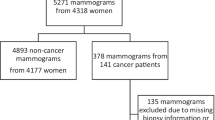Abstract
Digital mammography is a common screening method for early detection of breast cancer. Its efficiency varies from 60 to 90 %, depending on various factors such as breast density, quality of the mammogram as well as experience and knowledge of the radiologist (Andolina and Lillé in Mammographic imaging: a practical guide, Lippincott Williams & Wilkins, Philadelphia, 2010). One of the most effective ways to increase the cancer detection rate is double reading (Fernandez-Lozano in Soft Comput 19(9):2469–2480, 2015). Regarding the fact that only the early-stage patients have high chances of survival, a computer-aided detection (CAD) system for mammography that provides a second, independent diagnosis should be considered a valuable and lifesaving tool. In this paper we present a new heuristic approach focused on analyzing characteristics of the mammogram that may indicate the presence of breast cancer. Described soft computing detection algorithm based on local features allows us to extract microcalcifications and possible tumor areas from the image. Because calcifications are associated with certain types of lesions, we believe that this idea would result in improving existing medical information systems. Future inclusion of fuzzy classifiers in the algorithm may also provide additional diagnostic value. Conducted research confirms that proposed procedure correctly identifies the regions of interest and could be used as a base of a CAD system in a double-reading procedures.








Similar content being viewed by others
References
Andolina VF, Lillé SL (2010) Mammographic imaging: a practical guide. Lippincott Williams & Wilkins, Baltimore
DeSantis C, Ma J, Bryan L, Jemal A (2013) Breast cancer statistics, 2013. CA Cancer J Clin 61(6):409–418
Elguebaly T, Bouguila N (2015) A hierarchical nonparametric Bayesian approach for medical images and gene expressions classification. Soft Comput 19(1):189–204
Fernandez-Lozano C, Seoane JA, Gestal M, Gaunt TR, Dorado J, Campbell C (2015) Texture classification using feature selection and kernel-based techniques. Soft Comput 19(9):2469–2480
Grim J, Somol P, Haindl M, Danes J (2009) Computer-aided evaluation of screening mammograms based on local texture models. IEEE Trans Image Process 18(4):765–773
Hachaj T, Ogiela MR (2011) CAD system for automatic analysis of CT perfusion maps. Opto-Electron Rev 19(1):95–103
Hachaj T, Ogiela MR (2012) Visualization of perfusion abnormalities with GPU-based volume rendering. Comput Graph 36:163–169
Kannan SR, Sathya A, Ramathilagam S (2011) Effective fuzzy clustering techniques for segmentation of breast MRI. Soft Comput 15(3):483–491
Kopans DB (2007) Breast imaging. Lippincott Williams & Wilkins, New York
McCormack VA, dos Santos Silva I (2006) Breast density and parenchymal patterns as markers of breast cancer risk: a meta-analysis. Cancer Epidemiol Biomarkers Prev 15:1159–1169
Ogiela L, Ogiela MR (2014) Cognitive systems and bio-inspired computing in homeland security. J Netw Comput Appl 38:34–42
Siegel R, Ma J, Zou Z, Jemal A (2014) Cancer statistics, 2014. CA Cancer J Clin 64(1):9–29
Smith WL, Farrell TA (2014) Radiology 101: the basics & fundamentals of imaging. Wolters Kluwer, Philadelphia
Sohn VY, Arthurs ZM, Sebesta JA, Brown TA (2008) Primary tumor location impacts breast cancer survival. Am J Surg 195(5):641–644
The mini-MIAS database of mammograms—peipa.essex.ac.uk/info/mias.html—under license of the Mammographic Image Analysis Society
Yankaskas BC, Schell MJ, Bird RE, Desrochers DA (2001) Reassessment of breast cancers missed during routine screening mammography, a community-based study. Am J Roentgenol 177:535–541
Zakharova N, Duffy SW, Mackay J, Kotlyarov E (2011) The introduction of a breast cancer screening programme in a region with a population at medium risk for developing breast cancer: Khanty-Mansiysky autonomous Okrug-Ugra (Russian Federation). Ecancermedicalscience 5:195. doi:10.3332/ecancer.2011.195
Author information
Authors and Affiliations
Corresponding author
Ethics declarations
Conflicts of interest
The authors declare that they have no conflict of interest.
Ethical approval
This article does not contain any studies with human participants or animals performed by any of the authors.
Additional information
Communicated by V. Loia.
Rights and permissions
About this article
Cite this article
Ogiela, M.R., Krzyworzeka, N. Heuristic approach for computer-aided lesion detection in mammograms. Soft Comput 20, 4193–4202 (2016). https://doi.org/10.1007/s00500-016-2186-y
Published:
Issue Date:
DOI: https://doi.org/10.1007/s00500-016-2186-y




